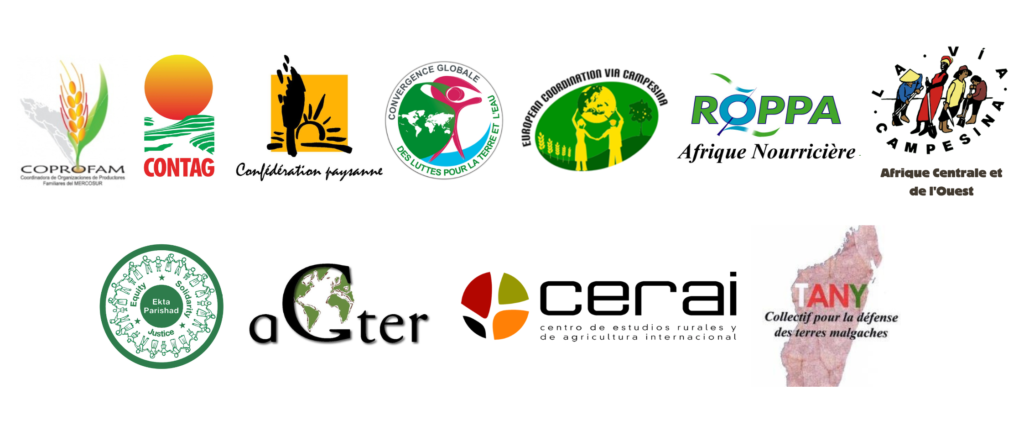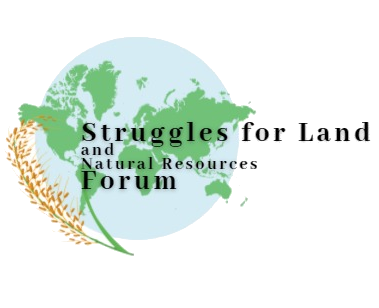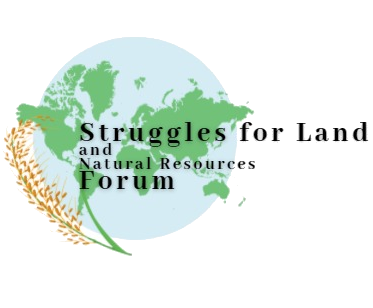A Brief History of Land Grabbing
A historical process of expansion of private ownership of land
Agriculture and land appropriation go hand in hand
Since the Neolithic period, various modes of appropriation have been progressively applied to land insofar as it was, in one way or another, transformed by human labour. Indeed, appropriating land can be a way of securing the fruits of one's labour: building, enclosing, enriching with organic matter, sowing and weeding every year in family orchards, clearing land for cultivation, developing plots of land into permanent meadows, developing forests, etc., all represent investments in labour that can be used to improve the quality of life.
However, until the end of the Middle Ages in Europe, and later elsewhere in the world, appropriation took forms that were far removed from the absolute private ownership of land as we know it today. In each context, the areas allocated to agriculture, livestock or forestry (annually cultivated plots, perennial plantations, grazing land, managed forests) are associated with a combination of use rights (limited in time or permanent, attributed to individuals, families, groups of various kinds) and collective obligations. Depending on the case, it is the 'village chiefs', 'landowners' or 'feudal lords' (among others) who grant the former and ensure that the latter are respected. In addition, much of the land remains under a regime of communal access (for hunting, gathering, gleaning, grazing or collecting wood) where the coveted resources develop spontaneously without requiring any particular work.
However, the development of private ownership of land is recent.
It was only late in history, from the 16th century onwards, but especially from the 18th century onwards, in the context of the emergence of capitalist market economies, that private ownership of land developed and became established in Europe. How does private property differ from previous forms of appropriation? Whoever owns land privately has not only one or more rights to use the resources that the land supports, but also more generally the right to decide how the rights of use can be applied to it and the right to dispose of it freely, i.e. to alienate it (sell or rent it at a certain price, pledge or mortgage it, give it away, pass it on to one's heirs, etc.) and to exclude any other person from these rights. Private ownership of land was thus imposed - through the enactment of laws (including enclosure acts) or through the use of violence - to the detriment of undivided common property, and set back the collective obligations that had weighed on most agricultural or forestry land. This process was to extend over several centuries in Europe, where it was accompanied by major transformations in agriculture, which in turn laid the foundations for the industrial revolution. It was to be applied more brutally, in the space of a few decades, in some of the colonial overseas territories.
Private ownership of land: securing the fruits of one's labour... or that of others.
Land ownership is a way for the farmer to secure the fruits of his labour. Indeed, the 'owner' of land can directly exploit the area he or she owns within the limits of his or her labour force (e.g. family) and access to inputs (seeds, fertilisers) and working capital (tools, equipment).
However, the control of land by a small number of owners can also be a way for them to claim the fruits of the labour of others. Indeed, whoever holds private property rights over a relatively large area of land has the possibility of handing over this land to sharecroppers or farmers in exchange for a land rent (in return for the establishment of fruit share or tenancy contracts) or of developing it directly by employing salaried farm workers (or, sometimes, in the past, slaves).
In such cases, the relationship between the landowner and the land taker - the ownership relationship - is generally asymmetrical and unequal. This imbalance can be compounded by the imbalance resulting from differential access to inputs and working capital.
Unequal property relations leading to the exclusion of the small peasantry.
In the European context, property relations were sometimes derived from the relations of domination that preceded them in time, i.e. feudal relations. Indeed, the local nobility managed to enclose their private properties by encroaching on the share of the communal land that belonged to the former farmers - the serfs, most often by violence (houses knocked down, peasant rebellions crushed). But the development of these property relations was also the prerogative of privileged classes in full emergence: rich gentlemen, merchants or wealthy farmers. Heirs to the dominant classes of the past or not, beyond the use of violence, they also had a real capacity to influence, in their favour, decisions in the political sphere. This was notably the case in England with the promulgation of successive Enclosure Acts, especially during the 18th and 19th centuries.
Generally speaking, it was those who had the means to develop the land (capital, equipment, more secure outlets for their products) who, taking advantage of a demarcation of private property that was undoubtedly more favourable than that reserved for the great mass of the peasantry, imposed the conditions under which the latter could have access to the land. Depending on the country, these land reorganisations resulted in a more or less significant exclusion of the small peasantry. While the majority of the small peasantry in England disappeared, reduced to agricultural wage labour, begging or emigration overseas, in France it was the large seigneurial and ecclesiastical estates that declined in favour of small and medium-sized property, albeit with a bias in favour of the bourgeoisie and the richest peasants.
There is a similarity between the changes in the status of land in Europe (including the enclosures in England) and those that took place in the colonies. This was the case in Latin America in the context of the development of agrarian capitalism, especially from the mid-19th century onwards; or in certain regions of India where the British colonial administration favoured the large landowners - zamindar - in order to better control the levies on its citizens. However, the changes that took several centuries in Europe were achieved in just a few decades overseas, which did not allow for the development of social adaptations or the development of industry that would have enabled the peasantry to be absorbed and excluded from access to land. Today, the phenomena of massive appropriation of agricultural land are moving much faster, and the implementation of regulatory mechanisms is even more difficult.
Inequalities in access to land exacerbated in India under British rule.
The British presence in India dates back to the 17th century with the establishment of the first trading posts and the growing influence of the East India Company on trade in the Indian Ocean. From 1757 onwards, the East India Company held political power on behalf of Great Britain over increasingly vast territories until 1858, when India came under the direct administration of the metropolis. It is only in 1947 that the country will know its independence.
In a good part of the regions administered since 1757, the British will take over the pre-existing relations between big landowners (zamindar) and farmers: sharecropping or farming accompanied by abusive levies. The British administration will rely on the zamindar to collect taxes from the farmers. At this level, it is worth noting that in 1841 the taxes collected by this means represented around 60% of the revenue that Great Britain, through the East India Company, obtained from its presence in India (Banerjee and Iyer, 2002). In most cases the existence of zamindar preceded the arrival of the British - as in Bengal (Kumar, 1982) - but in others it was the colonial power that reproduced this model (and the exploitative relationships that accompanied it) by appointing local authorities - this was the case in the Central Provinces (Baden-Powel, 1892). In both cases, the zamindar strengthened and increased their control over larger and larger territories and populations.
The hold of the zamindar was not the case everywhere in India: in some regions, the British administration levied taxes directly on small producers whose access to land was formalized and registered (Raiyatwari) or on village chiefs who regulated the access of each member of the community (Mahalwari) to collective land (Firoj High Sarwar, 2012). These different systems of levies of course had consequences for the distribution of land on the eve of independence. The one based on zamindar rule, precipitated radical land reform laws from the 1950s onwards, the effects of which were however mixed.
A massive land grab exacerbated throughout the last decade.
If the phenomenon of land grabbing must be understood in the historical perspective seen earlier, it must be taken into account that the proportions it is acquiring today require a closer look at its current determinants. In fact, it is as if, in a final push, the market was trying to get its hands on all the land that had previously remained beyond its reach. The countries of the African continent, which until now have remained relatively untouched by the extension of private ownership of land (with the exception of colonial companies), are now the most targeted by the assaults of major international investors, with an unprecedented rate of appropriation. So what are the accelerators of the current land rush? What areas are involved and where are they located?
Accelerators and moderators of inequalities in access to land.
The permanence and growth of inequalities in access to land are based on very unbalanced power relations between the different actors involved. These power relations have historically evolved into increasingly marked relations of domination of one over the other, as we have highlighted. This evolution has accelerated at certain times and places, and everywhere in the world, since the financial and food crises of 2007-2008. It is in this sense that we use the notion of accelerators here. In order to also include factors that, to some extent, counterbalance this historical trend - that of increasing inequalities in access to land - we also use the notion of moderators.
Financialization, agricultural price volatility and outsourcing of food supply.
The increase in land acquisitions around the world, which began in the early 2000s, took on particular importance in 2007-2008 at the very start of the global financial and food crises. The increased demand for land by various types of actors - sovereign wealth funds, investment funds, agribusiness companies - is primarily a response to an increase in the level and volatility of agricultural prices. This is said to be the result of a combination of factors, the relative weight of each of which is difficult to establish and remains a matter of debate.
Among these, agrofuel production is often cited, as well as the price of oil, the devaluation of the dollar, low interest rates, the reduction in cereal stocks, financial speculation, climatic accidents or the policies of certain countries restricting rice exports.
Food prices have been responsible for serious crises in the countries of the South and, in particular, for the "hunger riots" of 2008, and have prompted some states to outsource food production, i.e. to produce the food needed for national demand outside their borders. This is particularly the case for those countries that depend on cereal imports to feed their populations, such as the Gulf States, but also, in general, for those that wish to guarantee sufficient supplies for their growing populations (and increasingly demanding animal products), such as China or India. To this end, private or public companies from these countries buy or lease for long periods of time large areas of land in other countries, which are then used to produce food for the markets of the countries where the investments were made.
The search for new sources of profit and rampant speculation in a world increasingly dominated by finance.
The process of massive land appropriation is gaining momentum as, following the widespread financial crisis from 2007 onwards, agricultural commodity prices are calling on investors for new potential sources of profit. The factors that determined the rise in agricultural prices are far from over, which leads one to believe that investment in agricultural production and land acquisition will continue, even if it may go through cyclical phases of less intensity. This is because private investors, including large banking companies and pension funds, are increasing 'safe' investments, including speculative investments in commodity markets and also in the acquisition of rights to agricultural land. Speculation will shift from the real estate and financial products that fuelled the 'bubbles' that burst from 2007 onwards and, according to IMF and World Bank experts, will focus on predictable demand for food, biofuels and fibre, but also on payments for environmental services, including those in the carbon markets that are being built.
References:
1 Mazoyer and Roudart, 1997 [History of agriculture in the world. From the Neolithic to the contemporary crisis]
2 Mazoyer and Roudart, 1997 [History of agriculture in the world. From the Neolithic to the contemporary crisis]
3 Mazoyer and Roudart, 1997 [History of agriculture in the world. From the Neolithic to the contemporary crisis]
4 Mazoyer and Roudart, 1997 [History of agriculture in the world. From the Neolithic to the contemporary crisis]
5 Merlet, 2010 [Different systems of access to land in the world. The case of Latin America]
6 Polanyi, 1983 [The Great Transformation. The Political and Economic Origins of Our Time]
7 Merlet, 2010 [Different Regimes of Access to Land in the World. The case of Latin America]
8 Zoomers 2010 [Globalization and the foreignization of space: seven processes driving the current global land grab] ; Baxter, 2010 [Africa's land and family farms - up for grabs?]
9 World Bank, 2011 [Rising Global Interest in Farmland. Can it yield sustainable and equitable benefits?]
10 Headey and Fan, 2008 [Anatomy of a crisis: the causes and consequences of surging food prices]
11 Mitchell, 2008 [A Note on Rising Food Prices]
12 Headey and Fan, 2008 [Anatomy of a crisis: the causes and consequences of surging food prices]
13 Zoomers, 2010 [Globalization and the foreignization of space: seven processes driving the current global land grab]; Borras et al, 2013 [The Challenge of Global Governance of Land Grabbing: Changing International Agricultural Context and Competing Political Views and Strategies]
14 Cotula et al, 2009 [Land grab or development opportunity? Agricultural investment and international land deals in Africa]
15 Zoomers. 2010 [Globalization and the foreignization of space: seven processes driving the current global land grab]
16 World Bank, 2011 [Rising Global Interest in Farmland. Can it yield sustainable and equitable benefits?]


